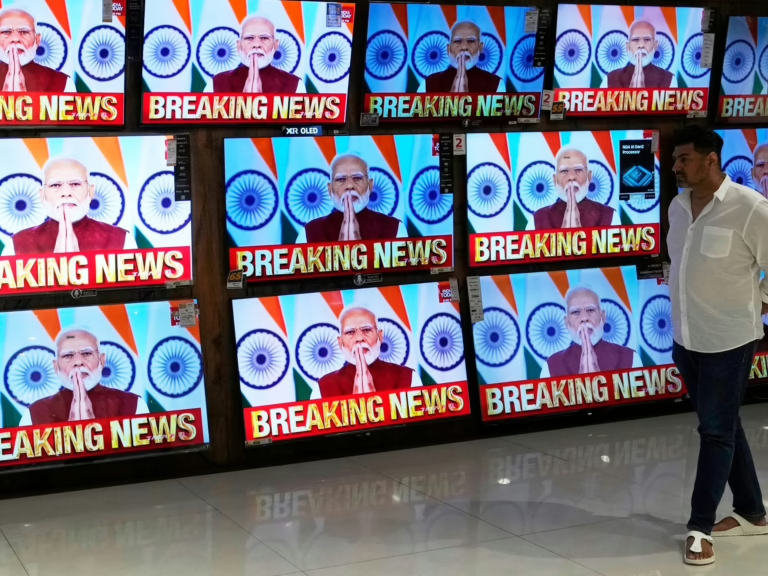Every dawn in contemporary India unfolds amid two contrasting narratives. On one hand, television channels present a polished discourse: heated discussions on Pakistan, celebrations of Hindu identity, and grand narratives about a “new India.” On the other, largely invisible to the broadcast audience, lies the harsh reality faced by Muslims-subjected daily to lynching, intimidation, imprisonment, and vilification. This duality sends a stark message: the anguish of Muslims is either erased from public consciousness or transformed into a spectacle, consumed as routine entertainment by the majority, while Muslims themselves are perpetually criminalized, accused without recourse, and silenced.
Consider the tragic death of a seven-year-old Muslim boy in Azamgarh this past September. His lifeless body was found concealed in a bag, discovered with chilling apathy by neighbors who were subsequently detained. The incident briefly surfaced in local news but was swiftly overshadowed on prime-time television by fiery debates on “love jihad,” border disputes, or the India-Pakistan cricket rivalry. The death of a Muslim child failed to ignite national outrage; instead, it was relegated to the growing archive of normalized brutality. Sociologist Stanley Cohen’s concept of “states of denial” resonates here-societies where atrocities are not hidden but so routinely absorbed that they cease to shock. This is the reality in India today: daylight lynchings of Muslims are dismissed by the majority as mere background noise.
Moreover, this hatred is not confined to silence; it is actively performed. When Muslims in Kanpur peacefully held placards proclaiming “I love Muhammad,” the police responded not with protection but by filing First Information Reports against 1,300 Muslims and conducting mass arrests. The simple expression of love was criminalized. Meanwhile, when Hindutva mobs assemble in Maharashtra or Madhya Pradesh, openly chanting genocidal slogans, media crews either glorify their actions or deliberately ignore them. Violence against Muslims has morphed into a theatrical spectacle, a narrative where Muslims are perpetually on trial, and Hindutva factions assume the role of self-appointed defenders of civilization.
This selective attention is intentional. The emergence of “jihadi-free markets” in Indore, where Muslim merchants were abruptly expelled, represents an economic lynching. Entire families lost their means of survival, children were withdrawn from schools, and women were left begging neighbors for sustenance. Yet, national media framed this as a mere “law and order” issue, barely acknowledging the human devastation. Hindutva groups celebrated online, turning the forced displacement of Muslims into viral amusement. What should have sparked nationwide condemnation was reduced to a routine “local disturbance.”
Chief Minister Yogi Adityanath epitomizes this culture of spectacle. From his official platform, he unleashes vitriol against Muslims, labeling them “infiltrators” and “terror sympathizers.” These are not marginal voices but those of the ruling elite. Meanwhile, opposition parties respond not with genuine outrage but by adopting diluted versions of Hindutva, competing to appear more “pro-Hindu” while silencing Muslim anxieties. This bipartisan consensus has made it clear: Muslims no longer exist as political agents in India; they have become mere political props.
The consequences extend beyond physical harm; they are psychological and existential. To be Muslim today is to live under constant suspicion-monitored in mosques, mistrusted in markets, doubted in classrooms. Every Friday prayer carries an undercurrent of risk. The call to prayer, the azaan, is perceived by some as a provocation, despite being the lifeblood of a community. The Urdu poet Sahir Ludhianvi once questioned, “jinhe naaz hai Hind par, woh kahan hain?” (“Where are those proud of India now?”). This question reverberates today: If this is the greatness of India, why must it be demonstrated through the daily humiliation of Muslims?
The Ugandan-born scholar Mahmood Mamdani offers a lens to understand this reality. In his seminal work Good Muslim, Bad Muslim, he describes how states and societies categorize Muslims into two groups: the “acceptable” Muslim who quietly submits, and the “dangerous” Muslim who resists or asserts dignity. In India, this division is weaponized daily. The Muslim who conceals their faith and remains invisible is tolerated; the one who openly embraces their identity-declaring “I love Muhammad,” demanding equal rights, or resisting erasure-is immediately branded as mujrim, a criminal. Mamdani emphasizes that this is not a theological issue but a struggle over power: who gets to define legitimacy and who must live under suspicion.
This dynamic explains why lynching videos circulate on WhatsApp like viral memes, why news anchors smirk while promoting conspiracy theories about a “Muslim population explosion,” and why mobs laugh after setting shops ablaze. Hatred has transcended politics; it has become a form of collective amusement. When cruelty is treated as comedy and humiliation becomes prime-time entertainment, the boundary between democracy and fascism has already dissolved.
History offers stern warnings: societies that transform the suffering of minorities into entertainment do not escape decay. The silence of German liberals during Nazi rallies, the indifference of Americans during the lynching of Black people, and the cheers of Israeli crowds during bombings in Gaza all serve as grim reminders that hatred-fueled entertainment ultimately consumes the society itself. India is no exception.
So, the question remains: Are we Muslims or mujrim? Why must we live perpetually on trial while perpetrators roam free? Why are the deaths of our children erased as the state celebrates its “Amrit Kaal”? The answer is not solely for Muslims to provide; it is for India’s majority to decide whether they will continue to consume hate as their favorite serial or finally turn off the screen.
Because when hatred becomes the nation’s primary entertainment, the final credits will not roll only over Muslim bodies-they will mark the demise of the Republic itself. History will not ask whether you were Hindu or Muslim, right-wing or liberal; it will ask why a society that once prided itself on civilization allowed cruelty to become comedy and silence to become consent. The challenge for India’s majority is no longer about tolerance or secularism; it is about whether they can still recognize the humanity in their neighbor.
If today you applaud the punishment of Muslims as mujrim, tomorrow you may awaken to find the very nation you cheered has become your prison, with the laughter of hate the only sound echoing through this Republic.






















